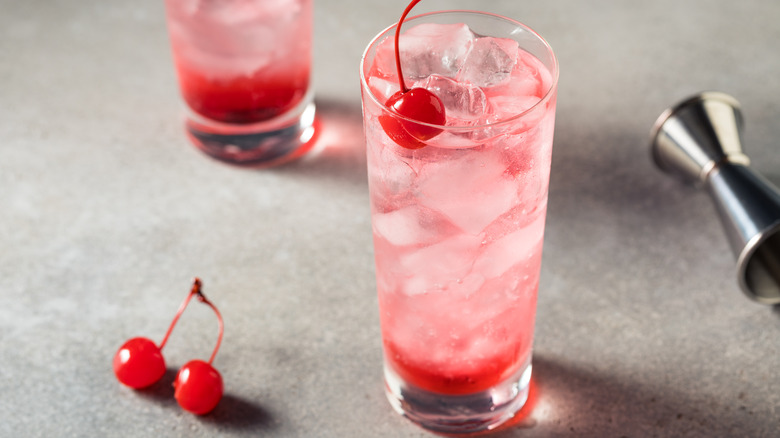The Boozy Origin Of Maraschino Cherries
Plopped into a drink or carefully placed on top of an ice cream sundae, maraschino cherries are the literal cherry on top. Whether you're familiar with the bright red adornment that characterizes a Shirley Temple mocktail or have been combing local grocery stores for dark, plump cherries to accent tonight's beverages, chances are you haven't given much thought to how exactly maraschino cherries came about. While you can try cooking up your own cherry syrup at home, we won't blame you if you'd prefer to simply place a store-bought extra finish on your drink and call it a day.
Cherries are delicate, easily bruised fruits. Once picked from their trees, cherries become tricky travelers. Yet hardship is often the foundation for great invention. It was determined farmers, after all, who gave candied cherries their start. And with the help of some fearless distillers and creative researchers, maraschino cherries have left an everlasting mark on the world of food and drink.
An unexpected twist
As Imbibe Magazine explains, farmers first mixed fresh cherries with alcohol after discovering cherries soaked in spirits were more easily transported. The maraschino cherry traces back to Dalmatia, a region in modern-day Croatia (but which was once part of the Kingdom of Italy).
In the 16th century, Dominican monks in Dalmatia distilled a specific type of cherry known as marasca; this would become known as maraschino (via My Istria). According to Epicurious, distillery Luxardo in Zara (modern-day Zadar) started to sell cherry liqueur and candied cherries in 1905, and continued to do so until World War II nearly took down operations (a fleeing family member escaped to Italy with a tree sapling and recipe in hand). The Luxardo brand continues to this day, marketing what it calls the "Original Maraschino Cherries."
It wasn't until the 1890s when marasca cherries were imported to the United States, particularly for hotels and restaurants catering to wealthier clients (via the National Cherry Festival). Yet booze-infused cherries were met with Prohibition laws, and sales were subsequently limited (per Science Made Fun). This is when an American professor came to the rescue.
Oregon-based professor Ernest Wiegand began to research whether cherries could be preserved sans alcohol, per the Cooking Channel. His experiments yielded a promising process, as detailed in The New York Times, one that incorporated calcium salt, a sugar-syrup, and an injection of red coloring. His candied treat gained so much popularity that it eventually overtook the exported variety, placing Oregon as a headquarters for maraschino-cherry production (via The Oregon Encyclopedia). Cheers, Professor Wiegand!

